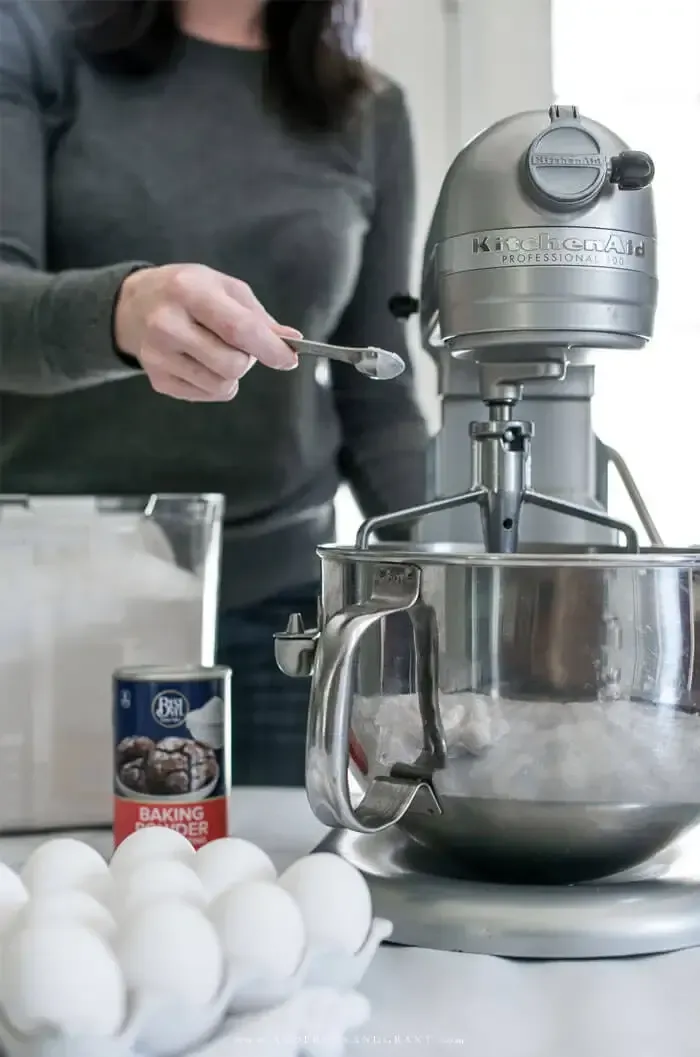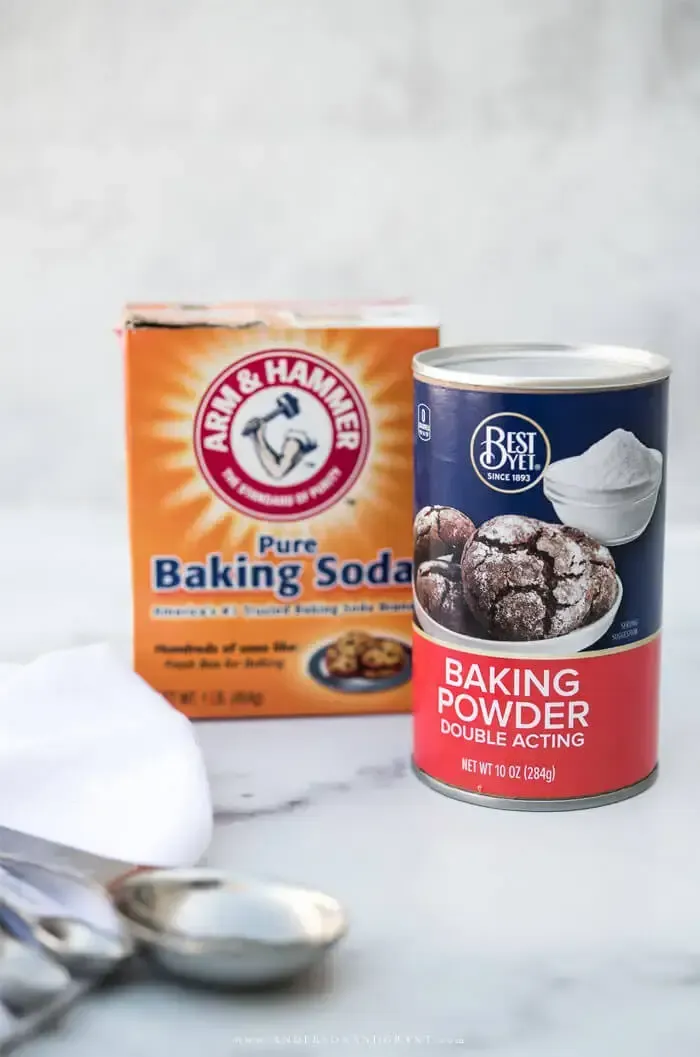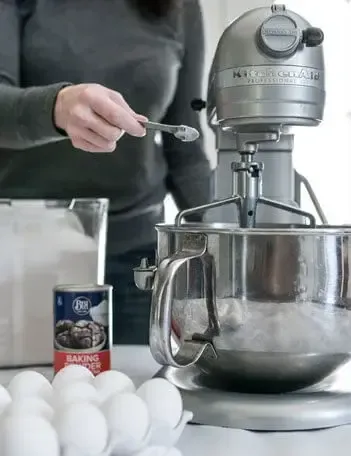Baking soda and baking powder share the same purpose in your recipes. But when used incorrectly, they are one reason why your cakes aren't fluffy and your cookies spread too thin. Read on to learn exactly how to use the two different ingredients and when you can substitute one for the other.
COOK + BAKE | Updated March 22, 2023

When mixing cookies, muffins and cakes, it is easy to misuse baking soda and baking powder.
The white powder ingredients look very much the same. Depending on the brand, they may even come in similar containers. And when quickly skimming through a recipe, you can no doubt misread one for the other if you aren't paying close attention.
Does it even matter, you might wonder? Can using the wrong one make that big of a difference to your finished baked good?
The answer is yes.
Baking powder and baking soda are both leavening agents, meaning that they make dough and batter rise. But chemically, the two ingredients work differently to make the rising happen, and using the wrong one can affect the flavor of your baked good.
So let's take a closer look at the differences between the two leaveners and find out exactly when to use one over the other (or both at the same time).

UNDERSTANDING THE DIFFERENCE BETWEEN BAKING POWDER + BAKING SODA
What is Baking Soda?
Baking soda, also known as sodium bicarbonate, is considered a base. As in science, the base has to be combined with an acid, like buttermilk (more on this below). When the two are mixed together, they produce carbon dioxide, bubbles form, and your cookie dough or cake batter rise.
Baking soda also enhances browning and gives baked goods their golden hue. A down side is the baking soda will make your cookies spread more because the acidity that would cause them to set faster has been neutralized.
The best way to understand this chemical reaction? Think back to your elementary school days where you watched a paper volcano filled with baking soda "explode" when you added vinegar. This is what happens on a smaller scale inside of your batter.
The carbon dioxide reaction happens only when baking soda comes into contact with both a liquid and an acid.
It takes place as soon as the ingredients are mixed together, so you'll need to get baked goods that include baking soda into the oven as soon as possible before the reaction slows down. (You can, however, mix your baking soda into dry ingredients like flour and sugar while preparing your recipe and let it sit without a problem.)
While you need enough baking soda to react with the amount of acid in the recipe and neutralize the flavor, too much baking soda for the amount of acid will create a metallic, soapy aftertaste in your baked goods.
A GOOD RULE OF THUMB: Use 1/4 teaspoon of baking soda per cup of flour in the recipe.

What are the Acids That React with Baking Soda?
If you look at the ingredient list of a recipe that includes baking soda, you should see an "acid" as well. Otherwise, the baking soda should not be of use in the baked good because there is nothing to make it do its job.
The following is a list of the most common acidic ingredients that you might use:
- Buttermilk
- Brown sugar
- Yogurt
- Sour cream
- Maple syrup
- Lemon juice
- Vinegar
- Cream of tartar
- Molasses
- Applesauce
- Natural cocoa powder (not Dutch processed)
- Honey
- Chocolate

So Then How Does Baking Powder Work?
Baking powder is a blend of baking soda, cream of tartar, and normally corn starch, a moisture-absorbing agent used to hold off premature reactions. It is considered an all-in-one leavener because it includes baking soda and the exact amount of acid (cream of tartar) to use up all of the baking soda. No additional acids are necessary to use baking powder in a recipe.
Most baking powder is double acting meaning there are two leavening reactions that occur. The first happens immediately when the baking powder gets wet, like when you combine wet and dry ingredients, and some bubbles will be produced.
The second leavening happens more slowly when the baking powder is exposed to heat. This is when most of the rising takes place, so double acting baking powder can sit for about 15 to 20 minutes before baking without losing its leavening power.
Using too much baking powder leaves baked goods with a bitter taste and causes batter to rise too rapidly before collapsing. The air bubbles that are created from the leavening reaction grow too large and then break, which causes your batter to fall leaving cakes tough and volume-less and cookies spread too thin.
A GOOD RULE OF THUMB: Use 1 teaspoon of baking powder per cup of flour in a recipe.

Can You Use Baking Soda and Baking Powder Together?
Some recipes call for both ingredients. In these instances, an acid is used to react with the baking soda, but the carbon dioxide created is not enough to completely leaven the volume of batter. The baking powder is used to add additional lift. Sometimes you need more leavening in a batter than you have acid available in the recipe.
A combination of the two is also used to enhance flavor and add tartness. For example, when making buttermilk pancakes, you want a tangy flavor. Baking soda would neutralize that taste, so baking powder is also included to add leavening to the pancakes. Both are necessary to produce a pancake that is light and tangy.
Can You Substitute Baking Powder for Baking Soda?
There are tutorials that will tell you how to substitute one ingredient for the other. But it is very tricky to get right and is not worth the chance of ruining your baked good. Baking powder and baking soda really are not interchangeable.
Because baking soda is stronger, you'll need about four times as much baking powder to get the same amount of rising reaction, but you'll end up with a bitter cookie or cake.
And substituting baking soda for baking powder means you'll need to increase the amount of acid (or add an acid), which will also change the taste and texture of what you make.

Baking is a science and there is a lot of action that takes place when ingredients are mixed together. It is helpful to have at least a small understanding of how your baked goods are formed to ensure what you remove from the oven is the best it can be.
CONTINUE READING THESE POSTS IF YOU'RE INTERESTED IN THE BAKING 101 SERIES: A collection of posts designed to help improve your baking skills.
Choosing the Right Oven Rack Location
Improve Your Baking Using Mise En Place

